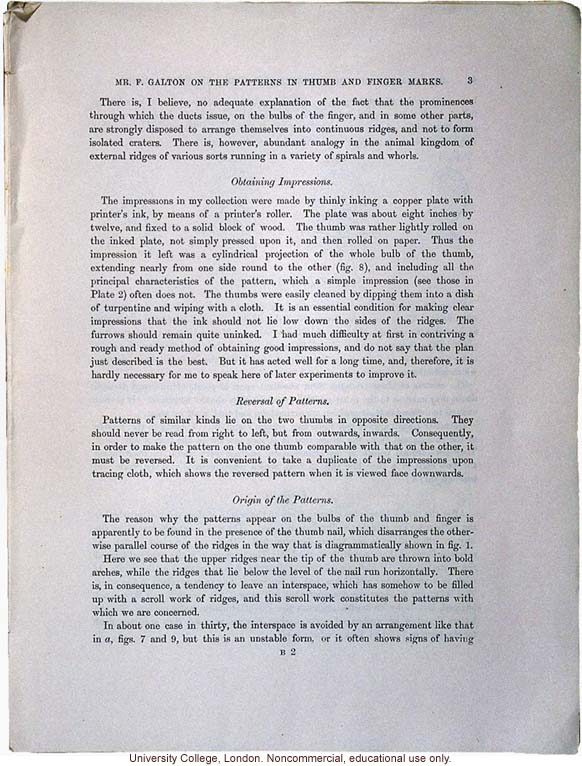Mr. F. Galton on the Patterns in Thumb and Finger Marks 3
There is, I believe, no adequate explanation of the fact that the prominences through which the ducts issue, on the bulbs of the finger, and in some other parts, are strongly disposed to arrange themselves into continuous ridges, and not to form isolated craters. There is, however, abundant analogy in the animal kingdom of external ridges of various sorts running in a variety of spirals and whorls.
[italics]Obtaining Impressions.[end italics]
The impressions in my collection were made by thinly inking a copper plate with printer's ink, by means of a printers' roller. The plate was about eight inches by twelve, and fixed to a solid block of wood. The thumb was rather lightly rolled on the inked plate, not simply pressed upon it, and then rolled on paper. Thus the impression it left was a cylindrical projection of the whole bulb of the thumb, extending nearly from one side to the other (fig. 8), and including all the principal characteristics of the pattern, which a simple impression (see those in Plate 2) often does not. The thumbs were easily cleaned by dipping them into a dish of turpentine and wiping with a cloth. It is an essential condition for making clear impressions that the ink should not lie low down the sides of the ridges. The furrows should remain quite uninked. I had much difficulty at first contriving a rough and ready method of obtaining good impressions, and do not say that the plan just described is the best. But is has acted well for a long time, and, therefore, it is hardly necessary for me to speak here of later experiments to improve it.
[italics]Reversal of Patterns[end italics].
Patterns of similar kinds lie on the two thumbs in opposite directions. They should never be read from right to left, but from outwards, inwards, Consequently, in order to make the pattern on the one thumb comparable with that on the other, it must be reversed. It is convenient to take a duplicate of the impressions upon tracing cloth, which shows the reversed pattern when it is viewed face downwards.
[italics]Origin of the Patterns[end italics].
The reason why the patterns appear on the bulbs of the thumb and finger is apparently to be found in the presence of the thumb nail, which disarranges the otherwise parallel course of the ridges in the way that is diagrammatically shown in fig. 1.
Here we see that the upper ridges near the tip of the thumb are thrown into bold arches, while the ridges that lie below the level of the nail run horizontally. There is, in consequence, a tendency to leave an interspace, which has somehow to be filled up with a scroll work of ridges, and this scroll work constitutes the patterns with which we are concerned.
In about one case in thirty, the interspace is avoided by an arrangement like that in a, figs. 7 and 9, but this is an unstable form, or it often shows signs of having
[end]


